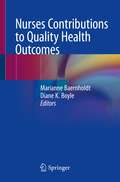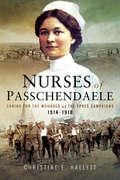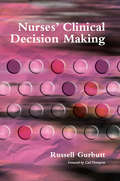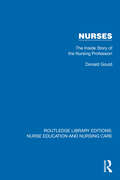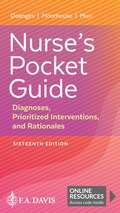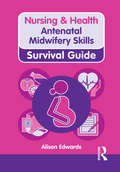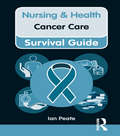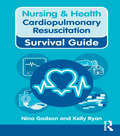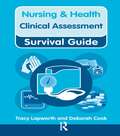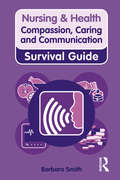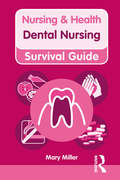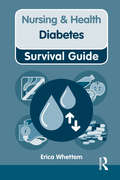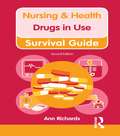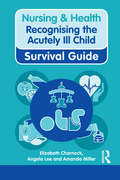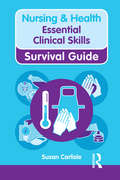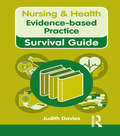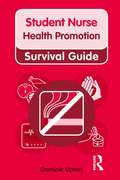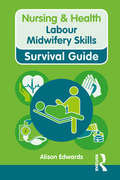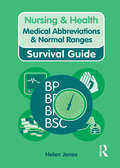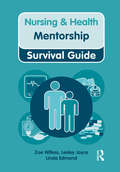- Table View
- List View
Nurses Contributions to Quality Health Outcomes
by Marianne Baernholdt Diane K. BoyleThis comprehensive book organizes the components of quality and safety outcomes, within a framework developed by expert nurses. Such a framework is missing in existing books on quality and safety in health care, and the concepts of nursing and organizational outcomes are often overlooked. This book fills this gap by exploring and expanding the various features of the Quality Health Outcomes Model (QHOM) and its four main concepts of System, Client, Interventions, and Outcomes. Using a broad and comprehensive approach, the authors identify the most current empirical evidence and concepts in the nursing field to provide an up-to-date understanding of the QHOM’s four concepts and their interrelations. New concepts include (a) systems concepts of turbulence and complexity of workflow and use of the electronic health record to support clinical workflow; (b) client concepts of social determinants of health, health literacy, and chronicity; (c) intervention concepts of interprofessional practice, nursing care processes including unfinished care, and care coordination; (d) outcome concepts related to nursing and the organization in addition to patient outcomes that includes the patients’ experience.The ideas, approaches, and evidence are provided by a team of experienced researchers, practitioners, and leaders. The author team presents an updated, state-of-art view of how system, client, and interventions affect client, nurse, and organizational outcomes.This book will appeal to researchers, clinicians, and researchers interested in healthcare quality and in particular nurses and nursing students in administration, research, and practice.
Nurses and COVID-19: Ethical Considerations in Pandemic Care
by Connie M. Ulrich Christine GradyThis book addresses the many ethical issues and extraordinary risks that nurses and others are facing during the COVID-19 pandemic, which creates physical, emotional, and economic burdens, affecting nurses' overall health and well-being. Nurses are essential front-line clinicians across all health care settings and in every nation. The COVID-19 pandemic caused by the novel SARs-CoV-2 virus has affected children, adults, and communities within and across all societies. Nurses, too, have contracted the virus and died from the disease. They have also seen their colleagues, family members, and friends hospitalized or in intensive care units struggling to survive. Nursing’s professionalism and disciplinary resolve to care for patients and families amidst confusion, misinformation, and shifting guidelines has been called “heroic” by the public. How much risk should nurses be expected to accept during a pandemic? How do nurses help patients and families find comfort and dignity at the end-of-life? How do we help nurses who are suffering from moral distress and mental health concerns from what they have seen, been asked to do, or are unable to provide? And, how does society move forward from a pandemic that has challenged our basic ethical principles of justice and what is “fair, good and right” in caring for those who need care, including the most vulnerable and nurses themselves? This book addresses these and other ethical concerns that nurses are facing in their day-to-day clinical practice; experiences shared with patients, families, and colleagues. Although this book was written while the pandemic was still raging across the United States and globally, the events needed to be told as they were unfolding. This book helps us to learn from both the successes and failures that are affecting so many across the globe, including those on whom the public relies on to provide quality, compassionate, and expert care when they are sick: nurses.
Nurses in Nazi Germany: Moral Choice in History
by Bronwyn Rebekah McFarland-IckeThis book tells the story of German nurses who, directly or indirectly, participated in the Nazis' "euthanasia" measures against patients with mental and physical disabilities, measures that claimed well over 100,000 victims from 1939 to 1945. How could men and women who were trained to care for their patients come to kill or assist in murder or mistreatment? This is the central question pursued by Bronwyn McFarland-Icke as she details the lives of nurses from the beginning of the Weimar Republic through the years of National Socialist rule. Rather than examine what the Party did or did not order, she looks into the hearts and minds of people whose complicity in murder is not easily explained with reference to ideological enthusiasm. Her book is a micro-history in which many of the most important ethical, social, and cultural issues at the core of Nazi genocide can be addressed from a fresh perspective. McFarland-Icke offers gripping descriptions of the conditions and practices associated with psychiatric nursing during these years by mining such sources as nursing guides, personnel records, and postwar trial testimony. Nurses were expected to be conscientious and friendly caretakers despite job stress, low morale, and Nazi propaganda about patients' having "lives unworthy of living." While some managed to cope with this situation, others became abusive. Asylum administrators meanwhile encouraged nurses to perform with as little disruption and personal commentary as possible. So how did nurses react when ordered to participate in, or tolerate, the murder of their patients? Records suggest that some had no conflicts of conscience; others did as they were told with regret; and a few refused. The remarkable accounts of these nurses enable the author to re-create the drama taking place while sharpening her argument concerning the ability and the willingness to choose.
Nurses of Passchendaele: Caring for the Wounded of the Ypres Campaigns 1914–1918
by Christine E. HallettThe Ypres Salient saw some of the bitterest fighting of the First World War. The once-fertile fields of Flanders were turned into a quagmire through which men fought for four years. In casualty clearing stations, on ambulance trains and barges, and at base hospitals near the French and Belgian coasts, nurses of many nations cared for these traumatized and damaged men.Drawing on letters, diaries and personal accounts from archives all over the world, The Nurses of Passchendaele tells their stories - faithfully recounting their experiences behind the Ypres Salient in one of the most intense and prolonged casualty evacuation processes in the history of modern warfare. Nurses themselves came under shellfire and were vulnerable to aerial bombardment, and some were killed or injured while on active service.Alongside an analysis of the intricacies of their practice, the book traces the personal stories of some of these extraordinary women, revealing the courage, resilience and compassion with which they did their work.
Nurses' Clinical Decision Making
by Russell Gurbutt Andy CartyThis work includes a foreword by Carl Thompson, Senior Research Fellow, Department of Health Sciences, University of York. This inspiring text offers guidance and innovative ideas for teaching and learning. It explains how nurses make clinical decisions through the development of narratives, and how, using narratives, nurses gain a far more intimate knowledge of the patient than doctors can. The book considers service delivery around patients, renegotiation of professional roles of medical staff and their boundaries of responsibility and authority. "Nurses' Clinical Decision Making" will appeal to all undergraduate and postgraduate students of nursing, registered nurses and nurse managers. Nurse educators, hospital managers, doctors and healthcare risk managers will also find the information contained here invaluable. 'If nurses are decision-makers how can their role and practice be explained? Can decision-making be taught and are there different levels of decision-making skill? If so, how can expert decision-makers be recognised? These are just some of the pertinent questions that need to be asked if we are to recognise and understand the centrality of clinical decision-making in nursing practice. Clinical work is complex and takes place in a complex environment that centres around individuals who themselves are physically, socially and spiritually complex. Clinical work also involves multiple participants (nurses, doctors, patients, physiotherapists, occupational therapists, pharmacists to name a few) who in the course of a days work can make scores of decisions.' - Russell Gurbutt, in the Preface.
Nurses' Handbook of Health Assessment
by Janet R. WeberThe perfect on-the-go companion to Health Assessment for Nursing, 7th Edition, this compact handbook gives students quick, convenient access to the latest nursing assessment guidelines and findings in a “see and do” format ideal for today’s fast-paced nursing practice. Streamlined, step-by-step guidelines and full-color illustrations detail everything students need to interview clients and conduct thorough physical assessments with ease.
Nurses' Handbook of Health Assessment (Nurses' Handbook Of Health Assessment Ser.)
by Janet R. WeberPublisher’s Note: Products purchased from 3rd Party sellers are not guaranteed by the Publisher for quality, authenticity, or access to any online entitlements included with the product. With step-by-step guidance that clearly demonstrates the “what,” “why,” and “how” of each phase of the assessment process, Nurses’ Handbook of Health Assessment is the perfect portable text for students and practicing nurses. Renowned for its holistic perspective and three-column format, this up to date reference and guide takes students through every stage of the nursing assessment for adults and special populations. Organized into four units that correlate with Health Assessment in Nursing, the handbook provides everything needed to perform a range of common assessment procedures with confidence. The compact layout is easy to absorb, color is used functionally, and it is abundant with clinical photos and illustrations as well as photos and illustrations of examination techniques. KEY FEATURES 3-column assessment tables: Show assessment techniques, normal findings, and abnormal findings side by side to enhance comprehension and to help students focus on key aspects of assessment. Special Populations Icons: Pediatric, geriatric, and cultural considerations for each body system show important variations for these special populations. Client-teaching Icons: Appear in client teaching sections to highlight this key information. Safety Tip Icons: Help identify safety tips and clinical tips--vital information needed to ensure best practice. Abnormal Findings boxes: Cue the student to important variations to note during assessment. Spiral binding allows the Handbook to stay open on any flat surface.
Nurses: The Inside Story of the Nursing Profession (Routledge Library Editions: Nurse Education and Nursing Care)
by Donald GouldNurses now, just as when this book was originally published in 1988, are underpaid and overworked and thousands are leaving the profession every year. But why do many more highly intelligent and well-educated men and women stick to such a difficult and ill-paid job? Donald Gould has tried to discover the answer to this question by interviewing all kinds of nurses. For most the many frustrations and hardships of their jobs are more than out weighted by the immense satisfactions of the daily round. As the stories told in Nurses reveal, the profession provides an opportunity for the exercise of every kind of talent, from the highly scientific skills demanded by intensive care, to ‘making do’ in remote Africa, from easing the approach to death to managing a workforce of thousands.
Nurse’s Pocket Guide: Diagnoses, Prioritized Interventions, And Rationales
by Marilynn E. Doenges, APRN, BC-Retired Mary Frances Moorhouse, RN, MSN, CRRN Alice C. Murr, BSN, RN-RetiredNursing & Health Survival Guide (Nursing and Health Survival Guides)
by Alison EdwardsA pocket-sized reference tool for quick access to crucial information in any community or antenatal setting. The Nursing & Health Survival Guides have evolved - take a look at our our app for iPhone and iPad.
Nursing & Health Survival Guide: Cancer Care (Nursing and Health Survival Guides)
by Ian PeateUnderstanding cancer is essential to providing effective nursing care to patients and families affected. This easy-to-use reference guide puts all the necessary information at your fingertips. The Nursing & Health Survival Guides have evolved - take a look at our our app for iPhone and iPad.
Nursing & Health Survival Guide: Cardiopulmonary Resuscitation (Nursing and Health Survival Guides)
by Nina Godson Ryan KellyDo you need guidance and information on CPR? Do you need to understand the procedures and guidelines that govern the use of CPR? If you do, this pocket-sized reference guide provides you with all the information you need to conduct CPR safely and successfully. The Nursing & Health Survival Guides have evolved - take a look at our our app for iPhone and iPad.
Nursing & Health Survival Guide: Clinical Assessment (Nursing and Health Survival Guides)
by Deborah Cook Tracy LapworthEvery contact with your patient is an opportunity for clinical assessment. Ideal for quick reference, this pocket-sized guide puts all the crucial information at your fingertips. The Nursing & Health Survival Guides have evolved - take a look at our our app for iPhone and iPad.
Nursing & Health Survival Guide: Compassion, Caring and Communication (Nursing and Health Survival Guides)
by Barbara SmithCompassion, caring and communication are all fundamental parts of patient care and something all health and social care workers encounter on a daily basis. This user-friendly reference guide will help you care for your patients in a person-centred way. The Nursing & Health Survival Guides have evolved - take a look at our our app for iPhone and iPad.
Nursing & Health Survival Guide: Dental Nursing (Nursing and Health Survival Guides)
by Mary MillerThe dental workplace is always busy, whether in a dental surgery or a dental department in a hospital. This pocket-size reference book puts all the vital facts and information at your fingertips. The Nursing & Health Survival Guides have evolved - take a look at our our app for iPhone and iPad.
Nursing & Health Survival Guide: Diabetes (Nursing and Health Survival Guides)
by Erica WhettemOn the increase worldwide, diabetes is well recognized as a complex and challenging condition. This pocket-sized guide puts diabetes information at your fingertips, equipping you with the essential knowledge and skills to deliver effective day-to-day diabetes care competently and confidently. The Nursing & Health Survival Guides have evolved - take a look at our our app for iPhone and iPad.
Nursing & Health Survival Guide: Drugs in Use (Nursing and Health Survival Guides)
by Ann RichardsUnderstanding how drugs work is made simple in this easy to use pocket-sized guide. Drugs in common use are described under each body system and will form an aid to your confident administration of drugs to fit your patients' needs. The Nursing & Health Survival Guides have evolved - take a look at our our app for iPhone and iPad.
Nursing & Health Survival Guide: Early Recognition (Nursing and Health Survival Guides)
by Amanda Miller Angela Lee Elizabeth CharnockEarly and accurate recognition of an acutely ill child is essential. Ideal for quick reference, this pocket-sized guide puts all the crucial information at your fingertips. The Nursing & Health Survival Guides have evolved - take a look at our our app for iPhone and iPad.
Nursing & Health Survival Guide: Essential Clinical Skills (Nursing and Health Survival Guides)
by Susan CarlisleWhether you’re a student nurse on clinical placement or a healthcare worker on a busy ward, you need practical guidance at your fingertips, fast! This pocket-sized guide will help you to provide safe, effective, everyday patient care. The Nursing & Health Survival Guides have evolved - take a look at our our app for iPhone and iPad.
Nursing & Health Survival Guide: Evidence Based Practice (Nursing and Health Survival Guides)
by Judith DaviesTaking an evidence-based approach is fundamental to ensuring good clinical practice, but it’s not always easy. This info-packed guide will be an invaluable resource throughout your healthcare or nursing studies and post-registration, helping you to understand the essentials of EBP theory and application, and develop new insights into healthcare practice. The Nursing & Health Survival Guides have evolved - take a look at our our app for iPhone and iPad.
Nursing & Health Survival Guide: Health Promotion (Nursing and Health Survival Guides)
by Dominic UptonTalking to patients is not always easy. Sometimes you have to deliver bad news or encourage them to change their behaviour such as quitting smoking or practicing safe sex. With this easy to use pocket-sized guide you can quickly access information on how to reach your patient with confidence whilst promoting a healthier lifestyle. The Nursing & Health Survival Guides have evolved - take a look at our our app for iPhone and iPad.
Nursing & Health Survival Guide: Infection Control (Nursing and Health Survival Guides)
by Barbara SmithEnsuring the prevention and management of infection is a critical aspect of nursing. With this pocket-sized reference book you have instant access to all the most important policies and procedures. The Nursing & Health Survival Guides have evolved - take a look at our our app for iPhone and iPad.
Nursing & Health Survival Guide: Labour Midwifery Skills
by Alison EdwardsIdeal for quick reference in any community or birth environment, this pocket-sized guide puts all the crucial information at your fingertips. The Nursing & Health Survival Guides have evolved - take a look at our our app for iPhone and iPad.
Nursing & Health Survival Guide: Medical Abbreviations & Normal Ranges
by Helen JonesPart of the skill of nursing and healthcare involves being able to decipher and understand the meanings of results and abbreviations. The aim and purpose of this handy survival guide is to supply you with the information which will help you understand this language, so that you can provide appropriate holistic care to your patients. The Nursing & Health Survival Guides have evolved - take a look at our our app for iPhone and iPad.
Nursing & Health Survival Guide: Mentorship (Nursing and Health Survival Guides)
by Zoe Wilkes Lesley Joyce Linda EdmondMentoring and practice assessment is an increasingly important aspect of your ongoing professional development, but can be challenging. This pocket-sized guide will provide you with essential tips to ensure you and your students really get the most out of the experience. The Nursing & Health Survival Guides have evolved - take a look at our our app for iPhone and iPad.
